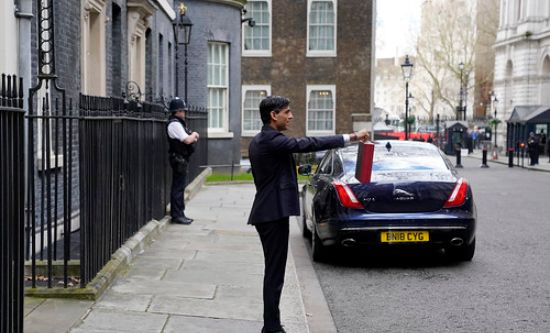
Announcing the government’s budget plans for 2021-22 and beyond, Chancellor Rishi Sunak on 3 March claimed that the British state would continue spending to support workers and businesses hard-hit by the Covid-19 pandemic. But Sunak warned that, ‘not popular, but honest’ plans for future tax rises were now needed for managing the growing public debt. Far from supporting ordinary people, Sunak’s budget paves the way for the government to continue as it has throughout the pandemic: using the state’s resources to save capitalism. WILL HARNEY reports.
Since the pandemic began, GDP has shrunk by 10%, the largest fall in 300 years, and there have been 700,000 job losses according to the Office for Budgetary Responsibility (OBR). £90bn in tax revenue has been lost as business has been curtailed by social distancing and repeated lockdowns. By the time of the budget, over £280bn had already been spent to prop up businesses and fund the public health response, including huge sums handed to private sector contractors without competition and with almost nothing to show for it in terms of controlling the pandemic.
The government cannot prop up the capitalist economy indefinitely; profit-making must resume and the wage system gradually take over from the Job Retention Scheme (in which around 5 million workers were still furloughed at the time of the budget) and Self-Employed Income Support Scheme (SEISS). Sunak revealed the government’s plan to phase out both of these schemes by October 2021 as restrictions on work and business are lifted through the ‘Roadmap’ out of national lockdown. The self-described ‘honest’ Sunak claimed that throughout the pandemic ‘our approach has been fair’, with ‘poor households benefiting the most’ from government support that would now be ‘extended’. This is a lie; inequality has exploded as the poorest workers have received the least support and now face far higher risk of unemployment (see FRFI 280).
At the same time, Sunak announced £65bn of giveaways for businesses over the next two years. The reduction in business rates has been extended until October at a cost of £6bn. A £25bn ‘super-reducer’ scheme will allow businesses to offset 130% of the cost of any investment in new plant and machinery against their tax bills in the next two years. Sunak’s hope is that this will bring forward £40bn in private sector investment that was already planned. The government is banking on a ‘bounce-back recovery’ of 7% growth in 2022-23 driven by this investment along with a flurry of consumption as the economy reopens; freezes on alcohol and fuel duties were also announced, and the limit on contactless payments raised to £100.
All of this means the pandemic cost to the public purse is set to reach £407bn over just two years. Consequently, the government has sanctioned the highest ever public borrowing outside of wartime, at £355bn, to cover the immense costs. Without future tax rises and cuts to spending, Britain’s debt will skyrocket. With the US alone unleashing $1.9 trillion in stimulus spending, there is a real possibility of rising global inflation and interest rates that would increase the cost of paying back Britain’s public debt to potentially ruinous levels. Sunak therefore took a step not seen from any chancellor since Denis Healey in 1974: announcing a rise in corporation tax, from 19% to 25% by the middle of this decade.
Sunak also revealed that income tax thresholds will be frozen from 2021 to 2026, creating 1 million higher-rate taxpayers. Much has been made of tax rises on businesses and the rich, but the cost to the poorest working-class people will be considerable. The lower threshold at which tax starts being paid will be frozen at £12,750, forcing 1.3 million people into the tax system and costing workers £8bn a year within five years. According to the OBR, Sunak’s various measures will raise tax revenues to their highest sustained share of GDP (35%) since the 1960s – prompting Paul Johnson of the Institute for Fiscal Studies to declare ‘we are in a new phase of UK economic history’.
Just as furlough ends in October and unemployment peaks at 6.5%, the so-called ‘uplift’ of £20 per week which increased the level of Universal Credit payments to some unemployed workers will also come to an end, reducing the income of the poorest by 7% and throwing 500,000 people, including 200,000 children, into poverty. A 2.2% increase in minimum wage from April 2021 will not compensate for this. With the cuts announced in the Autumn spending review, day-to-day public spending in 2024-25 is set to be £15bn lower than pre-pandemic spending plans – this austerity is how Sunak plans to keep the public debt sustainable without further tax rises. No extra support has been announced for the NHS beyond 2021-22, despite huge backlogs in operations caused by the pandemic and a mental health crisis – it will be back to decline. Nor was there even any mention of social care, a non-protected budget which has already seen cuts of 5% over the 2010s.
While households are supposedly sitting on £180bn saved up in the pandemic, the bottom 40% of households have depleted savings or gone into debt, according to the Joseph Rowntree Foundation. It is likely that the cash pile will be released slowly and unequally, with mainly rich areas benefitting from any ‘post-pandemic boom’. The Tory government calculates that a recovery will be apparent by 2023 and its main support bases will be largely protected, allowing another election win in 2025.
Responding to the budget, Socialist Worker (3 March 2021) declares: ‘It’s time for union leaders to begin a fightback for our side.’ The trade unions demobilised the resistance to austerity after the 2008 crash and have cooperated with the government throughout the current pandemic. Why would anyone expect them to ‘begin a fightback’ now? Over the next five years, the fightback will have to be built outside the unions, on the streets.




